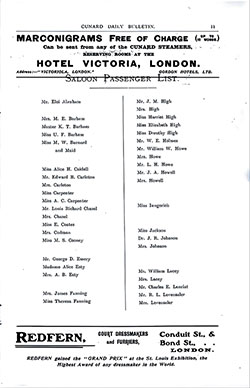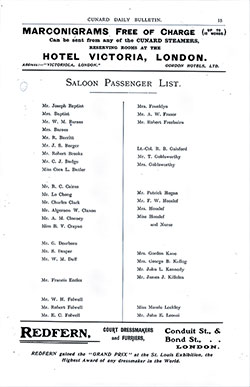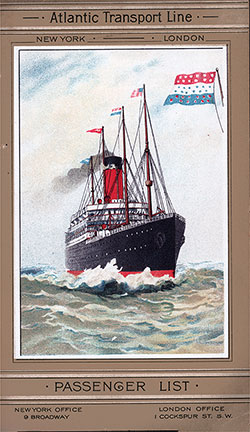Ellis Island Passenger Lists - 1905
Passenger lists for 1905 represent the souvenir list provided to the passengers of each cabin class (and other classes). Many of these souvenir passenger lists have disappeared over the years. Our collection primarily covers North American and European ports and ports in Australia and South Africa.
Our collection contains samples of passenger lists produced and printed by the steamship lines. These lists are often used to illustrate family history books for immigrants from this period.
Coveted by collectors and genealogists, souvenir passenger lists often offered beautiful graphical covers and information not found in official manifests because they focused on the journey rather than the destination.

1905-05-23 SS Kaiser Wilhelm der Grosse Passenger List
Steamship Line: North German Lloyd / Norddeutscher Lloyd
Class of Passengers: First and Second Cabin
Date of Departure: 23 May 1905
Route: Bremen to New York via Southampton and Cherbourg
Commander: Captain O. Cüppers

1905-05-23 SS Saxonia Passenger List
Steamship Line: Cunard Line
Class of Passengers: Second Cabin
Date of Departure: 23 May 1905
Route: Boston to Liverpool
Commander: Captain James Clayton Barr

1905-06-20 RMS Ivernia Passenger List
Steamship Line: Cunard Line
Class of Passengers: Saloon
Date of Departure: 20 June 1905
Route: Liverpool to Boston
Commander: Not Stated

1905-07-01 SS Caledonia Passenger List
Steamship Line: Anchor Steamship Line
Class of Passengers: List of Passengers on Clark's Excursions to Europe
Date of Departure: 1 July 1905
Route: New York to Glasgow via Londonderry

1905-07-22 RMS Umbria Passenger List
Steamship Line: Cunard Line
Class of Passengers: Saloon
Date of Departure: 22 July 1905
Route: Liverpool to New York via Queenstown
Commander: Captain T. Stephens

1905-07-29 SS Graf Waldersee Passenger List
Steamship Line: Hamburg Amerika Linie / Hamburg American Line (HAPAG)
Class of Passengers: First and Second Cabin
Date of Departure: 29 July 1905
Route: Hamburg to New York via Dover and Boulogne-sur-Mer
Commander: Captain A. Krech

1905-08-16 SS Friesland Passenger List
Steamship Line: American Line
Class of Passengers: Not Stated
Date of Departure: 16 August 1905
Route: Liverpool to Philadelphia
Commander: Captain C. J. Rogers

1905-08-19 RMS Pannonia Passenger List
Steamship Line: Cunard Line
Class of Passengers: Saloon
Date of Departure: 19 August 1905
Route: Trieste to New York via Fiume, Palermo, and Naples
Commander: Captain E. Pentecost

1905-08-23 SS Hellig Olav Passenger List
Steamship Line: Scandinavian America Line / Skandinavien-Amerika Linie
Class of Passengers: First and Second Cabin
Date of Departure: 23 August 1905
Route: Copenhagen to New York
Commander: Captain J. P. Holst

1905-08-30 RMS Majestic Passenger List
Steamship Line: White Star Line
Class of Passengers: First Class
Date of Departure: 30 August 1905
Route: Liverpool to New York via Queenstown (Cobh)
Commander: Captain B. F. Hayes

1905-09-09 SS L'Aquitaine Passenger List
Steamship Line: Compagnie Générale Transatlantique CGT - French Line
Class of Passengers: First and Second Cabin
Date of Departure: 9 September 1905
Route: Havre to New York
Commander: Captain Veblynde

1905-09-14 SS Hamburg Passenger List
Steamship Line: Hamburg Amerika Linie / Hamburg American Line (HAPAG)
Class of Passengers: First and Second Cabin
Date of Departure: 14 September 1905
Route: Hamburg to New York via Dover and Boulogne-sur-Mer
Commander: Captain E. Burmeister

1905-09-23 SS New York Passenger List
Steamship Line: American Line
Class of Passengers: First Class
Date of Departure: 23 September 1905
Route: Southampton to New York via Cherbourg
Commander: Captain W. J. Roberts

1905-09-30 SS Minneapolis Passenger List
Steamship Line: Atlantic Transport Line
Class of Passengers: First Class
Date of Departure: 30 September 1905
Route: New York to London
Commander: Captain Thos. F. Gates

1905-10-07 SS La Savoie Passenger List
Steamship Line: Compagnie Générale Transatlantique CGT - French Line
Class of Passengers: Cabin
Date of Departure: 7 October 1905
Route: Havre to New York
Commander: Captain Poirot

1905-11-11 SS Pennsylvania Passenger List
Steamship Line: Hamburg Amerika Linie / Hamburg American Line (HAPAG)
Class of Passengers: First and Second Cabin
Date of Departure: 11 November 1905
Route: Hamburg to New York via Boulogne-sur-Mer and Plymouth
Commander: Captain H. Knuth

1905-11-16 S. S. Minneapolis Passenger List
Steamship Line: Atlantic Transport Line
Class of Passengers: First Class
Date of Departure: 16 November 1905
Route: London to New York
Commander: Captain Thomas F. Gates

1905-11-18 RMS Lucania Passenger List
Steamship Line: Cunard Line
Class of Passengers: Second Cabin
Date of Departure: 18 November 1905
Route: Liverpool to New York
Commander: Captain J. B. Watt
Please help us make our passenger list collection more complete. We would appreciate a digital copy if you have an 1905 souvenir passenger list. Please email us at history@ggarchives.com.
Recap and Summary of the Ellis Island Passenger Lists - 1905 Index Page
The Ellis Island Passenger Lists for 1905 provide an extensive record of transatlantic and global ocean travel, showcasing the increasing demand for passenger services across multiple classes. This collection highlights voyages from major steamship companies, with routes connecting North America, Europe, and beyond.
By 1905, Ellis Island processed over 1 million immigrants, as steamship companies expanded their fleets to accommodate both wealthy travelers and working-class migrants. The growth of second-class and cabin-class accommodations reflects a shift away from steerage-only migration towards a broader passenger market.
This year's passenger lists include notable first-class voyages, luxury liners, and an increasing number of European shipping lines competing for dominance in transatlantic travel. Additionally, Boston and Philadelphia appear more frequently as arrival ports, reflecting immigration policy shifts and port expansions.
Notable Highlights from 1905 Passenger Lists
- SS Kaiser Wilhelm der Grosse (North German Lloyd) – 23 May 1905
- Route: Bremen to New York via Southampton and Cherbourg
- Passenger Class: First and Second Cabin
- Commander: Captain O. Cüppers
- Significance: This luxury liner was a symbol of Germany’s transatlantic dominance, competing with British and French liners for elite travelers.
- SS Saxonia (Cunard Line) – 23 May 1905
- Route: Boston to Liverpool
- Passenger Class: Second Cabin
- Commander: Captain James Clayton Barr
- Significance: The increasing number of voyages between Boston and Europe reflects Boston’s emergence as a primary immigration hub.
- RMS Ivernia (Cunard Line) – 20 June 1905
- Route: Liverpool to Boston
- Passenger Class: Saloon
- Significance: Saloon-class travel remained popular for business professionals, diplomats, and wealthy tourists, reinforcing Cunard’s appeal to elite travelers.
- SS Caledonia (Anchor Line) – 1 July 1905
- Route: New York to Glasgow via Londonderry
- Passenger Class: Clark’s Excursions to Europe
- Significance: This voyage catered to organized group excursions, marking the rise of pre-packaged transatlantic tours for wealthier passengers.
- RMS Umbria (Cunard Line) – 22 July 1905
- Route: Liverpool to New York via Queenstown
- Passenger Class: Saloon
- Commander: Captain T. Stephens
- Significance: The Umbria was a popular Cunard liner known for speed and luxury, serving wealthy transatlantic travelers.
- SS Graf Waldersee (Hamburg-Amerika Line) – 29 July 1905
- Route: Hamburg to New York via Dover and Boulogne-sur-Mer
- Passenger Class: First and Second Cabin
- Commander: Captain A. Krech
- Significance: Hamburg-Amerika Line was a major carrier for German, Eastern European, and Russian immigrants, contributing to the wave of Jewish migration to the U.S.
- SS Pannonia (Cunard Line) – 19 August 1905
- Route: Trieste to New York via Fiume, Palermo, and Naples
- Passenger Class: Saloon
- Commander: Captain E. Pentecost
- Significance: This route reflects the continuing influx of Southern European migrants, particularly Italians, Slavs, and Hungarians.
- SS Hellig Olav (Scandinavian America Line) – 23 August 1905
- Route: Copenhagen to New York
- Passenger Class: First and Second Cabin
- Commander: Captain J. P. Holst
- Significance: Scandinavian migration remained steady, with Danish, Norwegian, and Swedish emigrants seeking opportunities in the U.S. Midwest.
- RMS Majestic (White Star Line) – 30 August 1905
- Route: Liverpool to New York via Queenstown
- Passenger Class: First Class
- Commander: Captain B. F. Hayes
- Significance: First-class travel continued to thrive, with wealthy travelers favoring British ships for comfort and prestige.
- SS L'Aquitaine (CGT French Line) – 9 September 1905
- Route: Le Havre to New York
- Passenger Class: First and Second Cabin
- Commander: Captain Veblynde
- Significance: French steamships were renowned for elegance and cuisine, attracting elite passengers from both sides of the Atlantic.
- SS Pennsylvania (Hamburg-Amerika Line) – 11 November 1905
- Route: Hamburg to New York via Boulogne-sur-Mer and Plymouth
- Passenger Class: First and Second Cabin
- Commander: Captain H. Knuth
- Significance: This voyage reflects the massive German and Eastern European migration wave to the U.S..
- RMS Lucania (Cunard Line) – 18 November 1905
- Route: Liverpool to New York
- Passenger Class: Second Cabin
- Commander: Captain J. B. Watt
- Significance: Cunard’s Lucania was one of the fastest ships of its era, offering high-speed transatlantic crossings for second-class passengers.
Historical Context – Events Impacting Ocean Travel in 1905
1. Record Immigration at Ellis Island
- Over 1 million immigrants entered the U.S. in 1905, with the largest groups coming from Italy, Austria-Hungary, and Russia.
- The increase in second-class and cabin-class travel reflects a shift in migration patterns, as wealthier emigrants sought better conditions than steerage.
2. Growing Competition Among European Steamship Lines
- German, British, and French liners battled for dominance, as seen in the presence of North German Lloyd, Hamburg-Amerika, Cunard, White Star, and CGT French Line in this collection.
- The Kaiser Wilhelm der Grosse, Majestic, and Saxonia represented the height of luxury transatlantic travel.
3. Expansion of the U.S. Steamship Industry
- American-owned lines (American Line, Atlantic Transport Line) were expanding, offering luxury transatlantic service in addition to immigrant transport.
4. The Continued Rise of Boston and Philadelphia as Immigration Hubs
- Ships like SS Saxonia and RMS Ivernia highlight Boston’s increasing role in transatlantic migration.
- SS Friesland's arrival in Philadelphia shows the diversification of U.S. entry points for European immigrants.
5. The Russo-Japanese War and its Effects on Migration
- The 1904-1905 Russo-Japanese War disrupted trade routes and led to increased emigration from Russia and Eastern Europe.
- Steamships from Hamburg, Bremen, and Trieste saw a surge in Jewish, Polish, and Ukrainian emigrants fleeing military conscription and political instability.
Final Thoughts
The Ellis Island Passenger Lists for 1905 provide a compelling snapshot of global migration and elite transatlantic travel.
Key takeaways include:
- Over 1 million immigrants arrived at Ellis Island, with Boston and Philadelphia becoming major secondary immigration ports.
- A rise in second-class travel, signaling a shift in migration from steerage-only conditions.
- The increasing competition between German, British, and French steamship companies for dominance in transatlantic travel.
- Luxury liners continued to attract first-class passengers, while mid-range accommodations expanded for professionals and wealthier migrants.
- The effects of the Russo-Japanese War contributed to increased migration from Russia and Eastern Europe.
This collection provides a rich historical record of transatlantic and global ocean travel in 1905, highlighting the economic, political, and social factors shaping migration and maritime competition at the time.
In 1905, several significant world events impacted steamship and ocean liner travel:
-
Russo-Japanese War (1904-1905) Conclusion: The Russo-Japanese War, which concluded in September 1905 with the signing of the Treaty of Portsmouth, had significant implications for steamship travel. The end of hostilities led to changes in maritime routes and reduced military-related transportation demands, potentially affecting steamship schedules and operations in the region.
-
Technological Advancements in Steamships: Ongoing advancements in steamship technology continued to enhance the efficiency, speed, and safety of ocean liners. Innovations in engine design, hull construction, and navigation equipment further improved the reliability and comfort of steamship voyages.
-
Immigration Waves: Immigration to countries like the United States and Canada remained high, with steamships serving as the primary mode of transportation for millions of immigrants crossing the Atlantic. The continued influx of immigrants influenced steamship companies' operations and travel routes, particularly those catering to transatlantic voyages.
-
Geopolitical Developments: Various geopolitical developments, such as territorial disputes, colonial expansions, and international tensions, could impact steamship travel. Changes in political alliances and conflicts in certain regions might have influenced travel routes and passenger safety.
-
Economic Expansion and Global Trade: Economic growth and expansion of global trade continued to drive the demand for efficient transportation of goods and passengers via steamships. This economic prosperity further solidified the importance of steamship travel in international commerce.
-
Labor Strikes and Unrest: Labor strikes and unrest among seafaring workers occasionally disrupted steamship operations in different parts of the world. Disputes over working conditions, wages, and union rights could lead to temporary disruptions in ocean liner services.
-
Natural Disasters: Natural disasters such as storms, hurricanes, and maritime accidents could disrupt steamship travel by causing delays, damage to vessels, or loss of life. These events underscored the risks associated with ocean travel and the importance of safety measures implemented by steamship companies.
While 1905 didn't feature any single event as monumental as the conclusion of the Russo-Japanese War in the previous year, these ongoing trends and developments continued to shape the landscape of steamship and ocean liner travel, reinforcing their role as crucial modes of global transportation.
